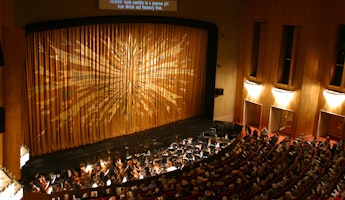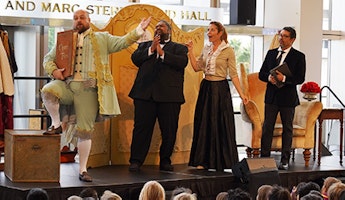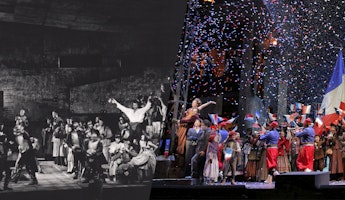Blog
September 4, 2023
Don Giovanni the Unknowable
Don Giovanni, the Unknowable: A Classical Antihero
Donna folle! indarno gridi, Chi son io tu non saprai!
Crazed woman! In vain you scream! Who I am, you will not know!
Don Giovanni, Act One, scene one
To me belongeth vengeance and recompense; their foot shall slide in due time: for the day of their calamity is at hand, and the things that shall come upon them make haste.
Deuteronomy 32:35
The story of Don Juan had been around at least since the early 17th century, and his legend has grown to the point that each subsequent century has had its say on the subject. Our own, barely two decades in, is equally active. Like its eponymous protagonist, the story’s chameleon-like narrative has been wrapped in many different philosophical and literary garments.
In 1787, Wolfgang Amadeus Mozart and Lorenzo da Ponte conferred on the subject a seriousness and universality that has ensured its permanence in our culture. This article purports to do very little but to bear witness to that phenomenon. Like The Marriage of Figaro, its predecessor in the Mozart-da Ponte trilogy, its plot is located at the nexus of sexual and class politics. It portrays several burning social issues similar to those our contemporary society grapples with today: sexual abuse, violence and the suppression of the rights of the underprivileged at the hands of a more powerful social class.
In keeping with its transcendent supernatural subject matter, it expands outward from the "edges." Figaro's subtitle, La Folle Journée [the crazy day] has a morning, noon and night, and the subject ends there. Don Giovanni keeps opening outwards, each episode posing questions, each "answer" spawning more questions like the multi-headed Hydra.
Mozart is also the dramatic genius whose music elevated his operas into a towering orbit. Although it is true that Da Ponte was by far the best collaborator Mozart ever had, none of the poet's 30 operas he wrote for other composers have remained in the canonic repertory.
But of the many implications of this extremely complex narrative, there is an overwhelming presence that, at the beginning and the end, orients the listener. And it is accomplished without a word of text, nor preamble nor explanation. The terrifying power of the key of D minor, for Mozart, is the tonality of death and the supernatural. It presents a cautionary tale of divine justice: of the punishment for he or she who transgresses without repentance. The composer, so generous in his own clemency, pardoning most of his characters in most of his operas, has made a stunning and powerful exception. In an era in which even the portrayal of death on the stage was relatively rare and unfashionable, Mozart not only shows us the protagonist's demise in full view, but condemns and consigns him, in our presence, to eternal damnation.
Mozart dared to render the rigorous application of religious law in the theater. His bravery is all the more impressive as supernatural interventions and devilry were out of favor with the 18th-century Enlightenment era literati, as well as the public. Neither opera seria nor opera buffa featured death on the stage. (That was to change radically in the 19th century.) Not only do Mozart and Da Ponte show his death on stage, but most importantly they depict the terror of eternal punishment in such an arresting manner that the association of death and D minor, which Mozart also employed for the uncompleted Requiem, his last composition, reigned well into the 20th century. Starting with Beethoven, hardly a 19th-century composer could resist its magnetic pull. The damnation of Don Giovanni, as a scene, ranks with the greatest in operatic history.
The music's "moral" position concerning the protagonist is clear and, despite much of the literary musing of subsequent centuries, remains unmistakable. The moral decay, the cruelty and malignant antisocial narcissism of the man we know as Don Giovanni, who randomly seduced, betrayed and abandoned, merited a powerful and definitive punishment.
It is noteworthy, for those who may mistakenly think that Mozart and Da Ponte were glorifying the protagonist, that the original title was Il Dissoluto Punito ossia Don Giovanni [The Rake Punished, or Don Giovanni]. The condemnation of licentiousness and its eternal punishment are the pillars of the opera. The music alone is unmistakable in delivering that castigation. The final scene is awe-inspiring, such that neither believer nor nonbeliever can remain indifferent to its power.
That said, both creators were also masters of irony and complexity. The protagonist is also an extraordinary personification of a life force, generally represented by D major. Writing on Don Giovanni is both difficult and easy, perhaps unnecessary and/or superfluous given that the subject has provoked a vast and unending commentary since its creation. Easy, because there is so much to say. Primarily, the music speaks for itself. Secondarily, so much has been written about it that it is virtually impossible to say something of importance or fundamentally new. Thirdly, almost any position the writer might take on the whole subject or any of its details, including those set forth in this article, can be challenged and dismissed by an infinite number of equally valid (or invalid) viewpoints.
A saying, often attributed to Artur Schnabel, holds that “A masterpiece is a work that is better than any of its possible performances.” No dramatic portrayal or musical interpretation is definitive. Every question or choice suggests its opposite. What do we imagine are Donna Anna's secrets, which transpired at the beginning of the opera? Why does she vacillate between strength and weakness, attraction and disgust with Don Giovanni. Is Donna Elvira a heroine of self-definition and compassion or a helpless victim of her own obsession? What does Don Ottavio feel for Anna and she for him? Is Zerlina a naive innocent or a wily hard-nosed peasant who bargains for more than she can handle? Is Masetto simply a commedia dell'arte punching bag or a flesh and blood victim of aristocratic abuse? Who can confidently elucidate the relationship between Leporello and Don Giovanni, the servant and master, Is the opera more comedy with serious undertones, or deep and searing human narrative, with occasional comic relief? And so on, ad infinitum.
No interpretation can achieve all of the possible explanations. No viewpoint, either about the opera Don Giovanni or its eponymous protagonist, is complete, and thus immune to criticism or rejection. The work is unfathomable in its depths, uncontainable in its breadth, and inexhaustible in its essence.
The story seems to have originated with a play attributed to the Spanish monk Tirso de Molina, who curiously never acknowledged its authorship. It was entitled El Burlador de Sevilla y Convidado de Piedra [The Trickster of Seville and the Stone Guest]. Don Juan, as it came to be known, would have many new settings—by certain counts over 1,700 in the centuries following its creation. Most versions were performed by popular traveling theater groups, and often not written down. They gradually gravitated north eastward to France and Italy in the 17th century and further afield to central Europe. Moliere's controversial 1665 five-act comedy (!), controversial at the time, is to this day one of the few versions that has survived. Da Ponte knew it and he also knew preeminent Italian playwright Carlo Goldoni's 1736 Don Giovanni Tenorio well. He also borrowed copiously from a contemporary Venetian operatic version entitled similarly to Goldoni's tragicommedia, composed by one Giuseppe Gazzaniga and librettist Giovanni Bertati—who referred to it as a dramma giocosa [jocular or playful drama]. This curious appellation had been especially popular in the Neapolitan theater since the mid-18th century and was retained by Mozart and Da Ponte.
In an era of strict stylistic differentiation, the creators, in a Solomonic manner, split the difference between comedy and drama by including elements of both opera seria and buffa and appropriately apportioning those elements to reflect each character's social status. Donna Anna and Don Ottavio, the aristocratic couple, sing much of their music in the seria style. Zerlina, Masetto and Leporello, the peasant and working class, are straight out of opera buffa. And Donna Elvira, probably coming from the emerging middle class, whom Mozart described as "di mezza carattere." meaning the role is a hybrid of seria and buffa elements. The protagonist himself and his music defy categorization.
Over his lifetime, Mozart consistently raised the entire buffa genre to a higher level, incorporating profound human emotions and, at times, elevating it to the sublime. Nobody can any longer consider Don Giovanni as a comedy, but the dramma giocosa gave both composer and librettist cover to take advantage of both styles in fashioning what would become an opera for the ages, and, whether they intended or not, elevated the subject matter and gave birth to Don Giovanni, a modern myth. Had they not alighted on it, the less than serious tale of the burlesque Don Juan might have eventually died out.
The “new” Don Giovanni captured the imagination of some of the greatest writers (and composers) of the next two centuries. The list is long, but its most prominent exponents were Lord Byron, Alexander Pushkin, E.T.A. Hoffmann and Søren Kierkegaard at first, to be followed later by Charles Baudelaire, George Bernard Shaw and Albert Camus. And when they wrote about Don Giovanni, they wrote not about Don Juan Burlador, but as the world had come to know him, through Mozart and Da Ponte.
This cautionary tale of evil punished, and the infinite complexity, richness and ambiguity of the human soul, inspired each age to see it through its own particular lens. As the 19th century gradually lost interest in sin and salvation and reshaped itself, it saw him as a reflection of its own yearnings and philosophies. It melded, perhaps confused, the Don with Goethe’s Faust, both a faux hero and his nemesis Mephistopheles. Faust, perpetually searching for knowledge, had his quest, it was said, and Don Giovanni, constantly seeking satisfaction for his appetites, his conquests. More significantly, it suggests that Giovanni is constantly striving for the Eternal Woman, Goethe's "Ewig Weibliche" and is further driven by his perpetual disappointment.
The Don was for some an “antihero” who drove himself to self-destruction through his insatiable drives and dragged others along with him. For others, the Don was a melancholy protagonist of a self-defined drama, heroically seeking some illusionary anti-social grail of his own making. In each case, the 19th century often contradicted itself but found a use for this story to say something about its own preoccupations. It saw a mirrored image of itself. In the 20th century, Don Juan was to undergo a radically different evaluation under the microscope of psychoanalysis. The earlier portrait of a flawed, but defiant hero of Romanticism, in all the ambiguity that that image suggests, gave way to that of a psychopathic criminal. His Oedipal, malignant narcissism exhibited every form of neurosis and pathology in its current terminology. The remains of the 19th century's obsessive striving is being explained from the couch of the psychoanalyst.
And so on. Each age, including our own, sees in him and his story a reflection of its own world view. He now rightfully no longer represents anything good: he is a criminal predator, serial seducer and rapist. He is an abuser of women, an antisocial enemy of human morality and a paradigm of patriarchal and class privilege hubris.
In 2023, we can see that he is all appearance, with glowing substance-less charisma, and the self-confidence of a narcissistic personality disorder, free to roam, unconstrained by depth, knowledge or empathy. He has one talent, to read people's vulnerability and play with it as a toy. His aristocratic privilege allows him to escape accountability over the course of his life until, like the epitaph on the gravestone of the proverbial waiter, "God caught his eye."
Mozart and Da Ponte tell a fascinating tale, but one must search in vain to find evidence of the authors' sympathy for him. The work countenances neither his essence nor his behavior. It admits to a general fascination with him then concludes with divine punishment for his misdeeds.
Although Mozart’s framework for this resides in the supernatural rendering of divine justice, it should be understood that the abundant freedom with which he and Da Ponte create this theatrical drama has less to do with religious dogma than the infinite variety of the human experience. Don Giovanni and the Commendatore provide the pillars which hold up the edifice housing all of the other characters. Neither is fully human nor a pure incarnation of abstract principles. They have a human life but are simultaneously symbols, manifestations of powerful forces, polar antagonists. The latter is not the arbiter of divine judgment but the messenger who warns that the moment of repentance has come.
But who is the real Don Giovanni? Even the birth of his story, whose author has never been confirmed, is mysterious. He has been defined as a theoretical construct. In this view, Don Juan never existed nor, in reality, can exist. Taken literally, his story seems improbable, if not ludicrous. The sheer number of names in Leporello’s catalog removes it from the real world of and delivers it into the realm of fantasy and hyperbole. The exaggerated dimensions of his crimes invite theorizing, polemics and commentary. His raison d’être is one-dimensional: to subvert society through the abuse of women and the profligate exercise of his assumed aristocratic birthrights. To try to explain why he does so is, in a way, fruitless: he simply does so.
“Motiveless malignity,” Coleridge’s famous description of Iago’s character, leaves the “why” unanswered, and is a potent challenge to the possible futility of questioning what drives the Don. We meet him and the Commendatore, Donna Anna's father, on their last day. The Commendatore's personal history is unknown. In the opera, he does not have a name, just a title. His dramatic function is to die at Giovanni's hands, and then to return as a statue to deliver a divine warning, which is rejected. We accompany them both to their deaths. his last twenty four hours. They fulfill their dramatic function in this otherworldly drama of defiance and retribution as Divine Justice is meted out.
It has often been pointed out that Don Giovanni has no core to his personality. There is no “there” there. All we know about Don Giovanni is the depth and breadth of his misdeeds, but nothing at all about his person, who he is, nor how he came to be what he is. Mozart purposely deprives him of a self-revelatory or so-called confessional aria. Unlike Verdi’s Iago, who explains himself in his credo, the Don never reveals anything. His three solo "arias" are one-dimensional snapshots, neither multi layered nor complex. They illustrate, but do not explain, what propels him: voracious appetite, symbolized by wine (the drinking song), perpetual lust, seduction (the serenade) and violence (an action aria sung as he deceives then beats up Masetto).
All the other characters are fully human. Tomes are written, rightly, discussing the three women. They have produced a rich and ever-developing literature on their own. They are fascinatingly diverse. Theirs is a shared misfortune: they crossed paths with Don Giovanni, to have their erotic impulses challenged, violated, awakened, magnified and/or irrevocably changed. One assumes that the lives of all 2,065 women inscribed in Leporello’s catalog (whose list is assumed to include Donna Elvira) have been similarly impacted. Each principal woman develops in the course of events, and each is allotted arias in both acts to chart their growth (at least in the traditional version that emerged after the original Prague and Viennese premieres). None is left unscarred by having been in the orbit, however briefly, of this destructive roving planet.
At the end of the opera, Leporello, the servant, will seek another employer. Masetto, the peasant, will attempt to eke out a living off the land. Don Ottavio, of the landed aristocracy, will try to go forward with Donna Anna although Don Giovanni has struck close to home for both of them. Mozart does not prognosticate their future. Donna Elvira, who for me is the most evolved character of the entire story, will retire, at least for the moment, into a convent. Whether everyone’s lives are temporarily or irrevocably changed is a question that is left unanswered.
Together they all try, and fail, to retaliate against the Don. Retribution is the province of the divine. “Vengeance is mine saith the Lord,” we are told in the Scriptures, and so it is for our “antihero.” Greeks of antiquity were punished by the gods for hubris and defiance. The sin of Adam, however variously interpreted, is essentially that of disobedience. On the day portrayed in the opera, the Don, who has seemingly avoided accountability while riding herd on society through his legion sexual misdeeds, has become a murderer, and there, it seems, a line has been crossed. From that moment, we see him fail at all of us pursuits.
Mozart’s Don Giovanni has been, is, and will be, seen as all things to all people: monstrous sexual predator, amoral iconoclast, devil, intellectual pioneer, free agent of atheism, anarchy and nihilism, impiety and sacrilege, self-styled defender of Rationalism, mentally deranged psychopath. The list is endless. Through Mozart’s masterpiece, he has traveled the world through the centuries from the burlesque libertine of Tirso de Molina, for better or worse, to a fixture in our culture. Who he is is unknowable, and what he represents, a matter of perpetual enquiry and disagreement. And so, it is. He has always given us the slip, and always will. He himself told us so while escaping from Donna Anna in his opening line of the opera, uttering words as prophetic as they are emblematic: "Chi son io tu non saprai!"
"Who I am, you will not know!"
James Conlon has been LA Opera's Richard Seaver Music Director since 2006.
© 2023 James Conlon








/03-cosi/_dsc0996_pr.jpg?format=auto&fit=crop&w=345&h=200&auto=format)

















